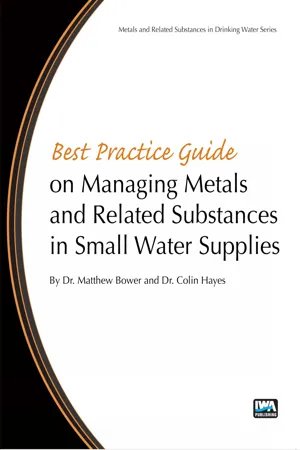
Best Practice Guide on the Management of Metals in Small Water Supplies
- 148 pages
- English
- PDF
- Available on iOS & Android
Best Practice Guide on the Management of Metals in Small Water Supplies
About this book
Table of contents
The Difficulties of Managing Water Quality in Small Water Supplies; What are Small Supplies?; The Management and Regulation of Small Water Supplies; The Vulnerability of Small Water Supplies to Contamination by Metals; Water Safety Plans for Small Water Supplies; Making WSPs Work for Small Supplies; Teamwork- The Value of a WSP Team; A Practical Guide to Developing a WSP for a Small Supply; Practical Guidance for Risk Assessments; Establishing the Metals Problem: Risk Assessment, Sampling and Analysis; The Range of Possible Problems; Metal Solubility and Influencing Factors; Risk Assessment of Small Water Supply Systems; Sampling and Analysis; Consumer Awareness; Sources of Metals in Small Water Supplies; Origin of Contaminants; Contamination of Surface Waters; Contamination of Ground Water; Contamination from Treatment Processes; Contamination in Distribution Pipework; Contamination from Plumbing Fittings; Water Treatment Processes Available for Use on Small Water Systems; Process Selection; Types of Treatment; Practical Considerations of Treatment for Metals in Small Water Supplies; Iron; Manganese; Conditioning of Water to Prevent Dissolution of Plumbing Materials or Post-treatment Contamination; Treatment is Only Part of the Story; Indications and Effects of Post-treatment Metal Contamination in Small Water Supplies; Establishing the Source of the Problem; Factors Controlling the Corrosion of Metals into Small Water Supplies; The Conditioning of Water to Minimise Corrosion; Manual of Individual Metals in Small Water Supplies, Aluminium, Antimony, Arsenic, Barium, Beryllium, Boron, Cadmium, Chromium, Cobalt, Copper, Iron, Lead, Manganese, Mercury, Nickel, Selenium, Tin, Tungsten, Uranium, Vanadium, Zinc; Case Studies; Arsenic removal in Small Supplies in Italy; A New Borehole Supply with Iron Removal for a Single Property in England, UK; Metals in Small Water Supplies in Areas of Water Scarcity in African Regions; Unexplained Lead Contamination of a Small Water Supply in Northern Scotland
EDITORS
Matt Bower, Drinking Water Quality Regulator for Scotland, UK
Colin Hayes, Swansea University, UK
Frequently asked questions
- Essential is ideal for learners and professionals who enjoy exploring a wide range of subjects. Access the Essential Library with 800,000+ trusted titles and best-sellers across business, personal growth, and the humanities. Includes unlimited reading time and Standard Read Aloud voice.
- Complete: Perfect for advanced learners and researchers needing full, unrestricted access. Unlock 1.4M+ books across hundreds of subjects, including academic and specialized titles. The Complete Plan also includes advanced features like Premium Read Aloud and Research Assistant.
Please note we cannot support devices running on iOS 13 and Android 7 or earlier. Learn more about using the app.
Information
Table of contents
- Cover
- Contents
- Authors
- Acknowledgements
- Abbreviations and Acronyms
- About this Best Practice Guide
- Foreword
- Executive Summary
- Chapter 1: The difficulties of managing water quality in small water supplies
- Chapter 2: Water safety plans for small water supplies
- Chapter 3: Establishing the metals problem: Risk assessment, sampling and analysis
- Chapter 4: Sources of metals in small water supplies
- Chapter 5: Water treatment processes available for use on small water supplies
- Chapter 6: Practical considerations of treatment for iron and manganese in small water supplies
- Chapter 7: Conditioning water to prevent dissolution of plumbing materials or post-treatment contamination
- Chapter 8: Manual of individual metals – occurrence, implications and management
- Chapter 9: Case studies